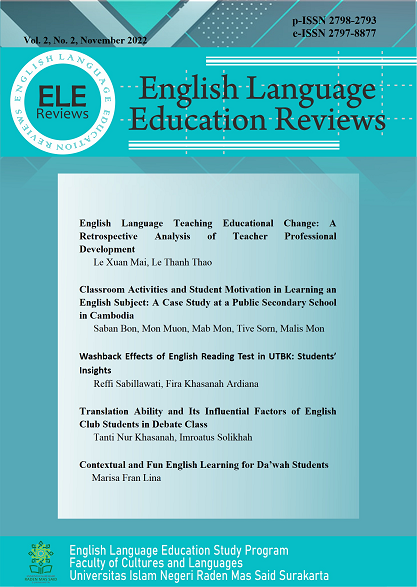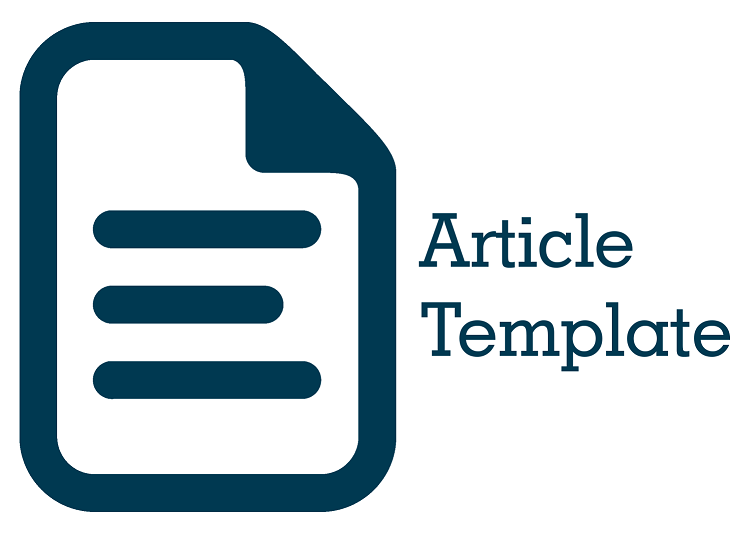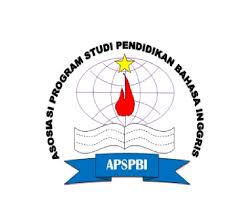Translation Ability and Its Influential Factors of English Club Students in Debate Class
DOI:
https://doi.org/10.22515/elereviews.v2i2.5481Keywords:
debate class, EFL learning factors, EFL students, translation, translation abilityAbstract
Translation is considered an essential element in the process of English learning. This descriptive qualitative study explores the translation ability and its influential factors performed by nine English club students of SMK Negeri 2 Surakarta in their debate class. Data were obtained by conducting a translation test. The students answered a questionnaire tested by the KR-20 formula to acknowledge the factors deeply. The results reveal that their ability to translate texts was good and excellent. Also, by using Microsoft Excel and interpreting using various theories in ELT, it was found that their ability was influenced by not only the external, internal, and individual factors but also their general learning strategies, way of learning vocabulary, teachers’ strategies in teaching grammar, and online tools as the part of learning media utilized by them. As translation becomes an inevitable process in ELT, these findings provide theoretical evidence that conducting TEFL by being attentive to the potential factors above and emphasizing the instructional designs is crucial. In addition, they directly influence the EFL learners’ translation ability, reflecting their English mastery and determining their success in the language learning process. Further, EFL teachers should pay more attention to their teaching strategy, consider allowing students access to online tools and motivate them to have a proper learning environment and reach optimal learning outcomes.
Downloads
References
Ahmadi, M. R. (2018). The use of technology in English language learning: A literature review. International Journal of Research in English Language Education, 3(2), 115-125.
Broughton, G., Brumfit, C., Flavell, R., Hill, P., & Pincas, A. (2003). Teaching English as a foreign language (2nd ed.). Routledge.
Chomsky, N. (2002). Syntantic structures (2nd ed.). Mouton de Gruyter.
DeKeyser, R. M. (2006). Foreign language instruction: Implementing the best teaching methods. Research Points, 4(1), 1-4.
Derakhshan, A. (2015). The difficulties of teaching English language: The relationship between research and teaching. International Journal of Linguistics, 7(1), 102-110. https://doi.org/10.5296/ijl.v7i1.6648
Ellis, R. (1994). The study of second language acquisition (1st ed.). Oxford University Press.
Ellis, R. (2015). Understanding second language acquisition (2nd ed.). Oxford University Press.
Ghazal, L. (2017). Learning vocabulary in EFL contexts through vocabulary learning strategies. Novitas-ROYAL (Research on Youth and Language), 1(2), 84-91.
Habibah, F. (2018). The correlation between students’ reading comprehension and their translation ability of analytical exposition text at the eleventh grade students of MA Ummatan Wasathan Pesantren Teknologi Riau. State Islamic University Sultan Syarif Kaim Riau Pekanbaru.
Imandari, R. Z., Suhartono, L., & Bambang, W. (2015). An analysis on English students’ ability in translating from English into Indonesian. Jurnal Pendidikan dan Pembelajaran Khatulistiwa, 4(12), 1-16.
Laviosa, S. (2014). Translation and language education (1st ed.). Routledge.
Lightbown, P. M., & Spada, N. (2013). How languages are learned (4th ed.). Oxford University Press.
Manowong, S. (2017). Incorporating online tools to promote English reading for EFL learners: An action research study. Pasaa Paritat Journal, 32(1), 98-124.
Miles, M. B., Huberman, M. A., & Saldaña, J. (2014). Qualitative data analysis: A methods sourcebook (3rd ed.). SAGE Publications, Inc.
Moleong, L. J. (2007). Metode penelitian kualitatif (Edisi Revisi). PT. Remaja Rosdakarya Offset.
Nababan, M., Nuraeni, A., & Sumardiono. (2012). Pengembangan model penilaian kualitas terjemahan. Kajian Linguistik dan Sastra, 24(1), 39-57.
Nassaji, H. (2015). Qualitative and descriptive research: Data type versus data analysis. Language Teaching Research, 19(2), 129-132. https://doi.org/10.1177/1362168815572747
Newmark, P. (1988). A textbook of translation (1st ed.). Pearson Education Limited.
Ningsih, R. W., Triani, H., Sihombing, Y. F., & Bangko, S. Y. P. M. (2019). Students' translation ability in English to Indonesian 2 Jambi University. International Proceeding ASEAN Youth Conference 2018 PPI-Malaysia (pp. 577-581).
Renandya, W. A. (2013). Essential factors affecting EFL learning outcomes. English Teaching, 68(4), 23-41.
Ruhansah, V. I. (2013). An analysis of students’ ability in translating grammatical equivalence. State Institute for Islamic Studies (STAIN).
Sundari, H., & Febriyanti, R. H. (2016). Translation techniques and translation competence in translating informative text for Indonesian EFL learners, 1(1), 17-28.
Sriwantaneeyakul, S. (2018). Critical reading skills and translation ability of Thai EFL students: Pragmatic, syntactic, and semantic aspects. English Language Teaching, 11(4), 1-14.
Whyatt, B. (2012). Translation as a human skill (1st ed.). Adam Mickiewicz University Press.
Wuttikrikunlaya, P., Singhasiri, W., & Keyuravong, S. (2018). The use of online tools in L2 writing: A study of Thai University students. Journal of English Language Teaching and English Linguistics, 30(1), 107-148.
Yessy, G., & Sinambela, E. (2018). An analysis of students’ ability in translating the analytical exposition text in eleventh grade of SMK N 11 Medan. Episteme, 4(2), 1-31.
Zainudin, I. S., & Awal, N. M. (2012). Translation techniques: Problems and solutions. Procedia - Social and Behavioral Sciences, 59, 328-334. https://doi.org/10.1016/j.sbspro.2012.09.282
Downloads
Published
How to Cite
Issue
Section
Citation Check
License
Copyright (c) 2022 Tanti Nur Khasanah, Imroatus Solikhah

This work is licensed under a Creative Commons Attribution-NonCommercial 4.0 International License.
Authors retain copyright and grant the journal right of first publication with the work simultaneously licensed under a Creative Commons Attribution License that allows others to share the work with an acknowledgement of the work's authorship and initial publication in this journal.
This ejournal system and its contents are licensed under
a Creative Commons Attribution-NonCommercial 4.0 International License








